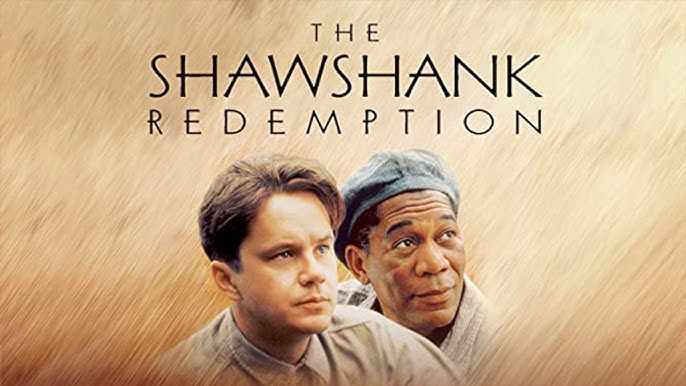”The Shawshank Redemption (1994)”

Suggested videos:
Suggested videos:
Suggested videos:
Suggested videos:
The Shawshank Redemption (1994), directed by Frank Darabont and based on Stephen King’s novella Rita Hayworth and Shawshank Redemption, is a critically acclaimed drama film that explores themes of hope, friendship, and resilience against the backdrop of a maximum-security prison.
Plot Overview:
The story follows Andy Dufresne (Tim Robbins), a successful banker who is wrongfully convicted of murdering his wife and her lover. Sentenced to two consecutive life terms at Shawshank State Penitentiary, Andy navigates the brutal realities of prison life. Despite the oppressive environment, he forms a close friendship with Ellis “Red” Redding (Morgan Freeman), a long-term inmate and the film’s narrator. Over the years, Andy uses his intelligence and resourcefulness to improve life in Shawshank for himself and his fellow inmates, including organizing a library, aiding in money laundering for the corrupt warden, and ultimately plotting his escape.
Key Strengths:
- Character Development:
- The film excels in its character exploration. Andy evolves from a reserved banker to a symbol of hope and resilience, while Red transforms from a cynical lifer to a man who believes in the possibility of freedom and redemption.
- Tim Robbins delivers a nuanced performance as Andy, portraying a range of emotions from despair to determination. Morgan Freeman’s portrayal of Red is equally compelling, with his rich voice adding depth to the narrative.
- Themes of Hope and Redemption:
- At its core, the film is about hope in the darkest of circumstances. Andy’s unyielding spirit inspires his fellow inmates, demonstrating that hope can be a powerful force even in the bleakest situations.
- The film’s exploration of friendship, particularly between Andy and Red, underscores the importance of human connection and support in overcoming adversity.
- Cinematography and Direction:
- Frank Darabont’s direction and Roger Deakins’ cinematography create a visually striking film that captures the stark realities of prison life while also highlighting moments of beauty and hope.
- The film’s pacing is methodical, allowing the audience to fully immerse themselves in the characters’ experiences and the passage of time within Shawshank.
- Screenplay and Dialogue:
- The screenplay is rich with memorable dialogue and poignant moments. The film balances heavy themes with moments of levity, making it both impactful and engaging.
- Quotes like “Get busy living or get busy dying” have become iconic, encapsulating the film’s central message.
- Emotional Resonance:
- The film evokes a wide range of emotions, from despair to elation. The powerful conclusion, which sees Andy’s successful escape and Red’s eventual journey to reunite with him, leaves a lasting impact on viewers.

- The film evokes a wide range of emotions, from despair to elation. The powerful conclusion, which sees Andy’s successful escape and Red’s eventual journey to reunite with him, leaves a lasting impact on viewers.
Weaknesses:
- Slow Pacing:
- Some viewers may find the film’s pacing slow, particularly in the early parts where character development takes precedence over action. However, this deliberate pacing is often viewed as essential for building emotional depth.
- Limited Female Characters:
- The film primarily focuses on male characters and the prison environment, leading to a lack of development for female characters. This may be a drawback for those looking for a more balanced representation.
- Realism vs. Idealism:
- Some critics argue that the film’s optimistic resolution may be overly idealistic compared to the harsh realities of prison life, though many viewers appreciate this hopeful perspective.

- Some critics argue that the film’s optimistic resolution may be overly idealistic compared to the harsh realities of prison life, though many viewers appreciate this hopeful perspective.
Legacy:
The Shawshank Redemption received seven Academy Award nominations, including Best Picture, Best Actor for Morgan Freeman, and Best Screenplay. While it initially underperformed at the box office, it gained immense popularity through home video and television, eventually becoming a cultural touchstone. It is frequently cited as one of the greatest films ever made and has a strong following, often appearing at the top of various “greatest films” lists.
Conclusion:
The Shawshank Redemption is a masterful film that combines powerful storytelling, exceptional performances, and profound themes. Its exploration of hope, friendship, and the human spirit resonates with audiences across generations, making it a timeless classic. The film’s ability to inspire and provoke thought about resilience in the face of adversity ensures its place in cinematic history as a compelling tale of redemption and the enduring power of hope.











